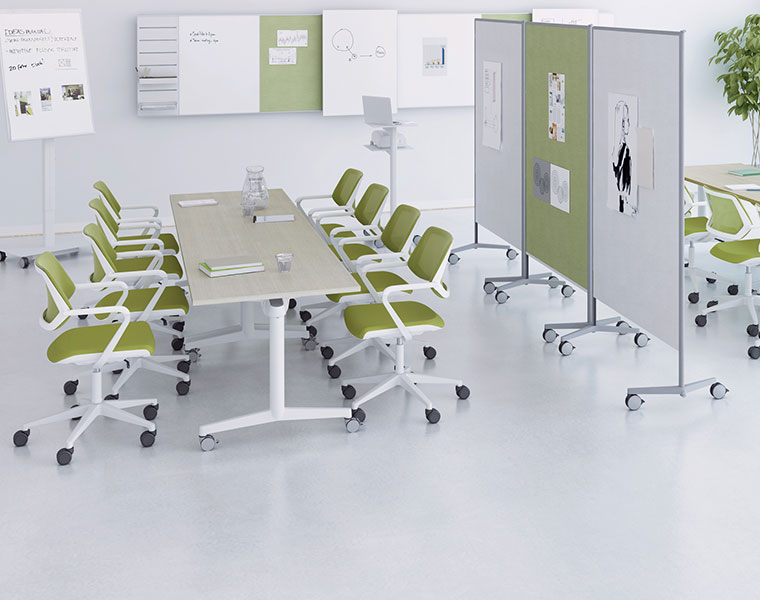When thinking about how to design an office presentation space, there are a number of important factors that you need to keep in mind. These include audio visual technology, power and data connectivity, ergonomics and multifunctionality. Some of this will come into play during the initial office fit out process but a lot is also down to things like choice of furniture, space configuration and other more variable design features.
You may very well find that you need to carry out a full office refurbishment in order to accommodate the requirements of a successful presentation space. However, it is worth investing some time and money into designing a great presentation room as it can be the difference between a team of demotivated employees and a workforce who are engaged, efficient and happy to come to work.
Now let’s look in more detail at some of the elements you should consider including in your presentation space…

Office furniture fit for purpose
As with all settings within a workspace, your furniture portfolio has the power to have a massive impact on productivity, creativity, motivation, comfort and wellbeing of those using it. As presentation spaces are somewhere that usually involve extended periods of sitting and concentration, getting the right furniture becomes even more important.
When choosing furniture for a presentation space, we would always advise keeping the following factors in mind:
• View and paths of site – you want everybody in the room to have an equal experience which means making sure the furniture you choose and the layout you decide on isn’t giving anybody an unfair advantage. Something like the Lano Table, for example, comes in a pear-shaped design to ensure everybody sat around it has an adequate line of vision.
• Modular furniture – In order to encourage collaboration and engagement, you need the space to break away from the boundaries of tradition and embrace more flexible ways of working. Modular furniture is easily reconfigured according to task and requirement and will also help maximise use of the space by making it adaptable and multi-purpose.

• Ergonomic furniture – Physical, long term comfort is key when it comes to picking out furniture for a presentation space and you will want to go for products which are intuitive and ergonomically designed to support a variety of postures and the natural flow of the human body.
• Technology integration – As we become more and more intrinsically connected to technology, it’s worth considering the many benefits of tech-integrated furniture. Merging seating solutions with power outlets, for example, is a great way to streamline the space and provide adequate resource.
• Soft seating – this comes into play when you are designing a breakout or social area to include as part of your presentation space. Again, we’ll go into more detail on that a little further on in the article.
Collaborative technology
Presentation spaces of the past created a clear divide between audience and speaker. This was reinforced through a lecture or classroom-style seating arrangement and a main screen controlled by the presenter. While this classic type of space configuration can still be effective, it’s important to now introduce additional design elements to make them more efficient.

These days, presentation rooms have become a lot more collaborative and creative to encourage greater levels of participation, idea-sharing and more dynamic ways of learning. Not only that – business owners and designers are now recognising the need to cater for the diverse spectrum of learning styles that don’t just involve listening and taking notes.
One of the ways this has really been bolstered is through the introduction of modern technology into our presentation areas. Some of the most popular ‘pieces of kit’ that we find have really helped our clients optimise their presentation spaces include:
• ClickShare – for more adaptable screen and information sharing (pictured above).
• Electronic room booking systems – to reduce disruption and aid time management.
• SMART Boards – for more reactive and interactive presentation styles which encourage participation.
• Video conferencing facilities – to make the space multifunctional and maximise its use to avoid it becoming redundant when presentations aren’t taking place.
As AV and technology become tools that we rely more heavily on, it’s paramount that you remember to provide sufficient power outlets and data connectivity when creating your presentation space. Users are likely to turn up with a whole plethora of different devices these days – from smartphones to tablets to laptops – so it’s essential that you provide them with the resource they need to use them.
While this might have been considered a luxury in the past, being able to plug in and power up has now become a modern-day necessity. Long gone are the days of notepads and pens.
A well-designed breakout area
Well-known professional speaker, Alf Rehn often talks about the importance of sticking to the 20-minute rule when presenting to an audience. Scientific studies have shown that the average human concentration span dwindles after around 18 minutes so it’s a good idea to cater for this within your presentation space design scheme by providing a place to literally breakout.

The best way to accommodate regular breaks is by creating a purpose-built breakout space where people can go to relax, rejuvenate and communicate more casually with colleagues or other people in the room. Not only will this enable them to return to focus in a refreshed frame of mind and absorb information more effectively, it will also boost collaboration and participation by encouraging better communication.
We have found that an effective breakout space typically includes the following features:
• Soft seating to create a relaxed and comfortable environment conducive to ‘taking a break’
• Power and data connectivity
• Communal seating such as benches to encourage interaction
• A place which provides privacy such as the BuzziMe chair in case focus is required
Noise-combatting acoustic solutions
A presentation room is one of the most prominent areas which calls for good acoustics. There’s no use in designing a visually-appealing space with all the technology bells and whistles if nobody can hear what is being said or presented.

For this reason, we would always recommend including some office acoustic solutions within your presentation space design scheme to help safeguard against any unwanted sound. Of course, you can implement this during the initial Shell & Core and Cat A fit out processes with features such as double-glazed windows and carpet flooring to aid sound absorption.
However, there are a number of innovative products on the market which can be added during the final Cat B fit out and installation phases which have been specifically designed to improve user acoustic experience. These include wall panels, ceiling panels, lighting and acoustically enhanced furniture which work to either block or reduce excess noise, echo and reverberation.
Click for further reading if you feel you need to brush up on your knowledge of the different types of office fit out.

